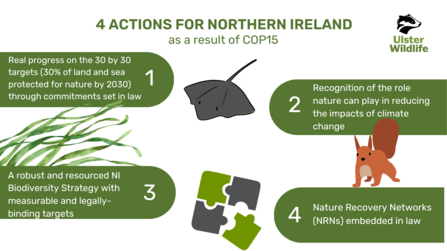What is COP15?
COP15, the UN Convention on Biological Diversity, is taking place from 7th - 19th December 2022 in Montréal, Canada following a two-year postponement due to Covid-19. Although not as well-known as the Climate Change COPs (such as last month’s COP27 in Egypt), both global conferences bring together nearly 200 countries to address planetary challenges that require urgent international action.
Why is it important?
The challenge is huge. Over the past 50 years, animal populations have declined by an average of 70% globally[1]. We are experiencing a mass extinction event, which is entirely relatable to human activity. Furthermore, the climate and biodiversity crisis are two sides of the same coin. Humanity’s viability, health and well-being are inextricably linked- as we lose nature, we put our existence at risk.
In Northern Ireland, we are subject to the loss of biodiversity both locally and further afield, as it impacts disease risk, food and goods supplies and market stability. NI is ranked 12th worst in the world for biodiversity loss out of 240 countries surveyed, one behind the Republic of Ireland (Natural History Museum and RSPB report, 2020), with 11% of our local wildlife threatened with extinction.





